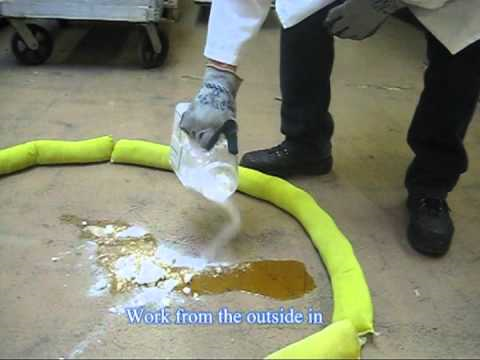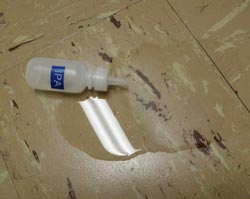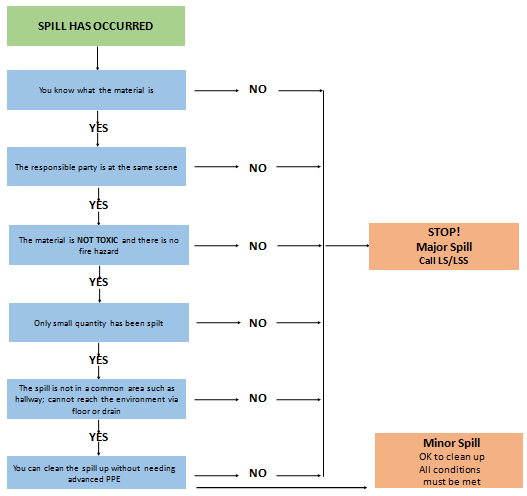When a chemical is spilled, you should decide whether the spill has minor or major (Figure C.1) property or personal risk to yourself and others.


Hazardous chemical or unknown material spill should only be handled by trained users. In case of any chemical spill (M)SDS must be addressed and the according procedures followed. While spills can be divided into general risk categories (as described bellow), an educated choice of action for any specific spill is in order. The flow chart bellow (Figure C.2) generalizes the decision making process to be applied while handling a spill.

Minor Risk
Spills that are stable, contained, isolated from public areas, and not posing an immediate health or environmental threat may be cleaned up by laboratory users who have been trained and are properly equipped to handle the situation. Spill kits are available in 2107 and G049.
When you notice a spill, if you think that it may be hard to find it again if you were to leave to get a spill clean-up kit, any absorbent towel or a lab coat should be placed over the spill should not be located around or so as to identify its location.
When the chemical spilled is likely to react with the towel or coat. Leave a warning sign or let co-workers know of the spill before you leave.
If the spill injured someone or damaged equipment or facilities, submit an accident report on 7444 and report LS/LSS.
Major Risk
For spills that present an immediate or significant physical, health or environmental risk, do the following:
- Evacuate all personnel from the area. If there is a risk to surrounding labs, pull the fire alarm to evacuate the area. Attend to injured personnel to the best of your training and experience.
When placing an emergency call, give the following information:
- Report the incident LS/LSS with your name, room location, room and cell phone number and brief injury/emergency description
- Remain at a safe location in the area to help emergency responders. Do not hang up until directed to do.
- LS/LSS will assist and advise departments on proper cleaning, packaging, and removal of any hazardous waste left behind. For some spills, faculty may need to bear the cost of clean-up by an outside contractor.
- Submit an accident report on LS/LSS.
Mercury Spills
The following discussion primarily pertains to metallic mercury (such as is in a mercury thermometer). Mercury may be easily absorbed through skin. Though, skin contact must be avoided during the cleaning-up process.
The inhalation is also the more serious way to expose to mercury, if the system involves heat. Because metallic mercury vaporizes very slowly at room temperature, mercury exposure will probably not be a health concern as long as the mercury is completely cleaned up.
Users must be trained in spill clean-up and use appropriate techniques and materials. Laboratories that use mercury or mercury-containing equipment should have a mercury clean-up kit immediately available. Users should evacuate the area and routine operations should not conducted until after the area has been shown to be clean.
Mercury spills at elevated temperatures may cause significant exposure and require immediate actions to turn off the heating elements and to evacuate the room until the surfaces involved in the spill have cooled.
An accident report must be submitted to LS/LSS.
Spill Clean-Up Waste
Waste generated from a spill clean-up should be placed in a container with a screw top closure or double bagged with waste procedure. Attach a chemical waste label with secondary waste boxes.
Hydrofluoric Acid Spill
If a major HF spill occurs, follow Spill Policy:
- Alert nearby users and evacuate to a safe distance.
- If a fire, explosion, or toxicity hazard exists, pull the fire alarm and follow building evacuation procedures, provide the relevant (M)SDS.
- If you have not pulled the fire alarm, close doors of affected areas and prevent re-entry. Put up “Do Not Enter” signs or barrier tape.
- Call 7444 LS/LSS to inform them of the situation.
- Do not re-enter the area until instructed to do so by LS/LSS.
If a minor spill occurs and you feel that you and your lab-mates are capable of addressing the spill, follow the Minor Spill Protocol with the following modifications:
- Notify LS/LSS.
- LS/LSS can assist with the cleanup.
- Obtain a HF spill kit from your lab and employ the HF neutralizer found therein. Only HF-specific absorbents should be used to address an HF spill. If such absorbents are not available, a large excess of dilute, aqueous calcium or magnesium hydroxide can be employed. The neutralization should be performed slowly in order to avoid an exothermic reaction (heat will vaporize HF and increase the risk of exposure).
Do not attempt to neutralize HF with the following:
- Sodium or Potassium Carbonate (“Soda Ash”, “Caustic Soda”): The reaction of Na2CO3 or K2CO3 with HF generates sodium or potassium hydrogen bifluoride (NaHF2 or KHF2) as intermediates, which release gaseous HF when exposed to heat.
- Potassium or Sodium Hydroxide (found in many acid-neutralizing kits): The neutralization of HF with potassium or sodium hydroxide is more exothermic than with sodium or potassium carbonate and also generates potassium or sodium hydrogen bifluoride (NaHF2 or KHF2) as intermediates, which release gaseous HF when exposed to heat.
- Silicon-based absorbent materials (common in most solvent spill kits) react with HF to generate silicon tetrafluoride, which is a toxic and corrosive gas.
References and sources for information from the relevant websites and documentation of different universities, NGOs and government agencies used in the preparation of this website are provided at references.